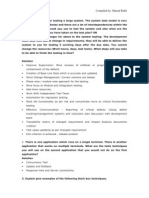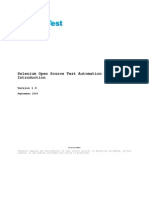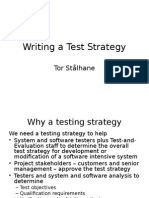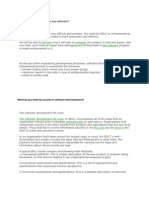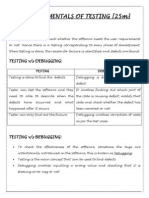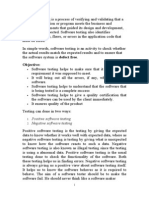SDLC V Model
SDLC V Model
Uploaded by
Mukul SoniCopyright:
Available Formats
SDLC V Model
SDLC V Model
Uploaded by
Mukul SoniOriginal Title
Copyright
Available Formats
Share this document
Did you find this document useful?
Is this content inappropriate?
Copyright:
Available Formats
SDLC V Model
SDLC V Model
Uploaded by
Mukul SoniCopyright:
Available Formats
http://www.tutorialspoint.com/sdlc/sdlc_v_model.htm Copyright tutorialspoint.
com
SDLC V-MODEL
The V - model is SDLC model where execution of processes happens in a sequential manner in V-shape. It is
also known as Verification and Validation model.
V - Model is an extension of the waterfall model and is based on association of a testing phase for each
corresponding development stage. This means that for every single phase in the development cycle there is a
directly associated testing phase. This is a highly disciplined model and next phase starts only after completion of
the previous phase.
V- Model design
Under V-Model, the corresponding testing phase of the development phase is planned in parallel. So there are
Verification phases on one side of the .V. and Validation phases on the other side. Coding phase joins the two
sides of the V-Model.
The below figure illustrates the different phases in V-Model of SDLC.
Verification Phases
Following are the Verification phases in V-Model:
Business Requirement Analysis: This is the first phase in the development cycle where the product
requirements are understood from the customer perspective. This phase involves detailed
communication with the customer to understand his expectations and exact requirement. This is a very
important activity and need to be managed well, as most of the customers are not sure about what exactly
they need. The acceptance test design planning is done at this stage as business requirements can be
used as an input for acceptance testing.
System Design: Once you have the clear and detailed product requirements, it.s time to design the
complete system. System design would comprise of understanding and detailing the complete hardware
and communication setup for the product under development. System test plan is developed based on the
system design. Doing this at an earlier stage leaves more time for actual test execution later.
Architectural Design: Architectural specifications are understood and designed in this phase. Usually
more than one technical approach is proposed and based on the technical and financial feasibility the final
decision is taken. System design is broken down further into modules taking up different functionality. This
is also referred to as High Level Design (HLD).
The data transfer and communication between the internal modules and with the outside world (other
systems) is clearly understood and defined in this stage. With this information, integration tests can be
designed and documented during this stage.
Module Design:In this phase the detailed internal design for all the system modules is specified,
referred to as Low Level Design (LLD). It is important that the design is compatible with the other
modules in the system architecture and the other external systems. Unit tests are an essential part of any
development process and helps eliminate the maximum faults and errors at a very early stage. Unit tests
can be designed at this stage based on the internal module designs.
Coding Phase
The actual coding of the system modules designed in the design phase is taken up in the Coding phase. The best
suitable programming language is decided based on the system and architectural requirements. The coding is
performed based on the coding guidelines and standards. The code goes through numerous code reviews and
is optimized for best performance before the final build is checked into the repository.
Validation Phases
Following are the Validation phases in V-Model:
Unit Testing: Unit tests designed in the module design phase are executed on the code during this
validation phase. Unit testing is the testing at code level and helps eliminate bugs at an early stage, though
all defects cannot be uncovered by unit testing.
Integration Testing: Integration testing is associated with the architectural design phase. Integration
tests are performed to test the coexistence and communication of the internal modules within the system.
System Testing: System testing is directly associated with the System design phase. System tests
check the entire system functionality and the communication of the system under development with external
systems. Most of the software and hardware compatibility issues can be uncovered during system test
execution.
Acceptance Testing: Acceptance testing is associated with the business requirement analysis phase
and involves testing the product in user environment. Acceptance tests uncover the compatibility issues
with the other systems available in the user environment. It also discovers the non functional issues such as
load and performance defects in the actual user environment.
V- Model Application
V- Model application is almost same as waterfall model, as both the models are of sequential type. Requirements
have to be very clear before the project starts, because it is usually expensive to go back and make changes.
This model is used in the medical development field, as it is strictly disciplined domain. Following are the suitable
scenarios to use V-Model:
Requirements are well defined, clearly documented and fixed.
Product definition is stable.
Technology is not dynamic and is well understood by the project team.
There are no ambiguous or undefined requirements.
The project is short.
V- Model Pros and Cons
The advantage of V-Model is that it.s very easy to understand and apply. The simplicity of this model also makes
it easier to manage. The disadvantage is that the model is not flexible to changes and just in case there is a
requirement change, which is very common in today.s dynamic world, it becomes very expensive to make the
change.
The following table lists out the pros and cons of V-Model:
Pros Cons
This is a highly disciplined model and Phases
are completed one at a time.
Works well for smaller projects where
requirements are very well understood.
Simple and easy to understand and use.
Easy to manage due to the rigidity of the
model . each phase has specific deliverables
and a review process.
High risk and uncertainty.
Not a good model for complex and object-
oriented projects.
Poor model for long and ongoing projects.
Not suitable for the projects where
requirements are at a moderate to high risk of
changing.
Once an application is in the testing stage, it is
difficult to go back and change a functionality
No working software is produced until late
during the life cycle.
You might also like
- StatementDocument5 pagesStatementVikash GoyalNo ratings yet
- Software Testing 54Document44 pagesSoftware Testing 54Sunkul CadhNo ratings yet
- IT8076-Software Testing PDFDocument10 pagesIT8076-Software Testing PDFJana S100% (1)
- Quality Center Interview QuestionsDocument5 pagesQuality Center Interview Questionsisk010123100% (1)
- SQM 16 & 2marks With AnsDocument21 pagesSQM 16 & 2marks With AnsKalyan SundaramNo ratings yet
- Jiro TechnologyDocument21 pagesJiro TechnologyvjjuNo ratings yet
- Chapter 3 - AnswerDocument2 pagesChapter 3 - Answerwynellamae100% (1)
- ISTQB Certified Tester Foundation Level SyllabusDocument204 pagesISTQB Certified Tester Foundation Level SyllabusHoney Methil100% (1)
- Manual Testing Real TimeDocument18 pagesManual Testing Real TimeRana KrunalNo ratings yet
- Software Testing by Yogesh KhairnarDocument13 pagesSoftware Testing by Yogesh KhairnarYOGESH KHAIRNARNo ratings yet
- TestingDocument123 pagesTestingEmy Saira thomasNo ratings yet
- Software Development Life Cycle (SDLC)Document39 pagesSoftware Development Life Cycle (SDLC)Prashanti PallavNo ratings yet
- Istqb Exam Sample Paper 1-3Document25 pagesIstqb Exam Sample Paper 1-3JaatfftNo ratings yet
- Testing 1Document12 pagesTesting 1so28081986No ratings yet
- Test QuistionsDocument1 pageTest QuistionsAhmed OmerNo ratings yet
- Software TestingDocument8 pagesSoftware TestingIJRASETPublicationsNo ratings yet
- MTP For Manual TestingDocument25 pagesMTP For Manual TestingCraig KrisNo ratings yet
- CSTE Test Cases Compiled By: Sharad RathiDocument4 pagesCSTE Test Cases Compiled By: Sharad Rathidhanabhakkiyam100% (1)
- Assignment 1Document4 pagesAssignment 1Deepak Wasge100% (1)
- Selenium Open Source Test Automation Framework: September 2009Document12 pagesSelenium Open Source Test Automation Framework: September 2009raj_esh_0201No ratings yet
- Basic Testing Qtn&ansDocument4 pagesBasic Testing Qtn&ansapi-3772931No ratings yet
- Software TestingDocument167 pagesSoftware TestingSamjas SubairNo ratings yet
- Interview QuestionsDocument13 pagesInterview QuestionsPrasad Ch0% (1)
- MANUAL-TESTING CompleteNotes 5septDocument55 pagesMANUAL-TESTING CompleteNotes 5septnaveen kumarNo ratings yet
- Create Page Object ModelDocument11 pagesCreate Page Object ModelmagillaniNo ratings yet
- Writing A Test Strategy: Tor StålhaneDocument32 pagesWriting A Test Strategy: Tor StålhaneJayson CeladiñaNo ratings yet
- TestLink User ManualDocument56 pagesTestLink User ManualsweepnoiseNo ratings yet
- Solutions Manual Software Quality AssuraDocument122 pagesSolutions Manual Software Quality AssuraRomero JangreNo ratings yet
- Smoke Test Sanity TestDocument7 pagesSmoke Test Sanity TestantoniealbertoNo ratings yet
- SDLCDocument4 pagesSDLCDada DildadaNo ratings yet
- SpringMVC NotesDocument6 pagesSpringMVC NotesEdin EleziNo ratings yet
- Testing FundamentalsDocument17 pagesTesting FundamentalsMallikarjun RaoNo ratings yet
- Defect & Test ManagementDocument12 pagesDefect & Test ManagementJU PMIT Sabuj0% (1)
- Review Techniques - Cost Impact of Software Defects, Code Review and Statistical AnalysisDocument27 pagesReview Techniques - Cost Impact of Software Defects, Code Review and Statistical AnalysispeterparkerspnNo ratings yet
- Software Testing by NithinbobDocument25 pagesSoftware Testing by NithinbobNayaz UddinNo ratings yet
- Cell Color in ABAP ALV Grid ReportDocument18 pagesCell Color in ABAP ALV Grid Reportviceawork01No ratings yet
- Set A Long Questions: (10 2 10) Attempt Any TwoDocument2 pagesSet A Long Questions: (10 2 10) Attempt Any Twosetup vpnNo ratings yet
- Manual Testing PDFDocument4 pagesManual Testing PDFmahesh100% (1)
- Executing The Test Plan: By: Abel AlmeidaDocument41 pagesExecuting The Test Plan: By: Abel Almeidaapi-373372650% (2)
- API Testing Ultimate Guide PDFDocument62 pagesAPI Testing Ultimate Guide PDFGetaneh AlehegnNo ratings yet
- Software Testing Is A Process of Verifying and Validating That ADocument61 pagesSoftware Testing Is A Process of Verifying and Validating That Asv0093066No ratings yet
- ALV DescriptionDocument13 pagesALV DescriptionharshalNo ratings yet
- TESTINGDocument13 pagesTESTINGPandu Ranga RaoNo ratings yet
- Orangehrm - My Info Module (Pmi) Live Project: Project Functional Requirement Specification Version 1Document21 pagesOrangehrm - My Info Module (Pmi) Live Project: Project Functional Requirement Specification Version 1Ioana Augusta PopNo ratings yet
- Chapter 2 - Testing Through Out Software Life CycleDocument30 pagesChapter 2 - Testing Through Out Software Life CycleVipul JainNo ratings yet
- Top 40 QA Interview Questions & Answers - 1548929780 PDFDocument9 pagesTop 40 QA Interview Questions & Answers - 1548929780 PDFEverald KevinNo ratings yet
- Latest Research and Development On Software Testing Techniques and ToolsDocument5 pagesLatest Research and Development On Software Testing Techniques and ToolsnovitaNo ratings yet
- Code Review E Book Greiler V2Document21 pagesCode Review E Book Greiler V2greatsun0No ratings yet
- 12 Integration TestingDocument18 pages12 Integration Testingajax248590No ratings yet
- 29 Software Engineer Interview QuestionsDocument10 pages29 Software Engineer Interview QuestionsDaphine KamukamaNo ratings yet
- Software Testing QBDocument5 pagesSoftware Testing QBNarender SaivalNo ratings yet
- Static Program AnalysisDocument11 pagesStatic Program AnalysisCa RlNo ratings yet
- MC5304 Programming With Java PDFDocument162 pagesMC5304 Programming With Java PDFAjay ShindeNo ratings yet
- Statement Decision Testing Coverage Istqb Foundation Exam Exercise Book SampleDocument9 pagesStatement Decision Testing Coverage Istqb Foundation Exam Exercise Book SampleShaji RamakrishnanNo ratings yet
- Assignment Software EngineeringDocument11 pagesAssignment Software EngineeringNadia Baker0% (1)
- Software Requirements DocumentDocument17 pagesSoftware Requirements Documentgim688No ratings yet
- ISTQB Latest Sample Paper 1Document9 pagesISTQB Latest Sample Paper 1Kiran KumarNo ratings yet
- ISTQB Foundation Sample Question Paper NoDocument63 pagesISTQB Foundation Sample Question Paper NoRaven LyNo ratings yet
- Making Sense of Agile Project Management: Balancing Control and AgilityFrom EverandMaking Sense of Agile Project Management: Balancing Control and AgilityNo ratings yet
- Upload Sllabus ICSEDocument5 pagesUpload Sllabus ICSEMukul SoniNo ratings yet
- Upload Sllabus ICSEDocument5 pagesUpload Sllabus ICSEMukul SoniNo ratings yet
- PoemDocument1 pagePoemMukul SoniNo ratings yet
- Bce, Bhagalpur 4 Year C.S.E.,2014 Time:-2 Hours F.M.:-15 Answer Any Three Sub:-A.IDocument1 pageBce, Bhagalpur 4 Year C.S.E.,2014 Time:-2 Hours F.M.:-15 Answer Any Three Sub:-A.IMukul SoniNo ratings yet
- Year C.S.E.,2014 Time:-2 Hours F.M.:-15 Answer Any Three Sub:-S.EDocument2 pagesYear C.S.E.,2014 Time:-2 Hours F.M.:-15 Answer Any Three Sub:-S.EMukul SoniNo ratings yet
- And So On.: Digital Number SystemDocument21 pagesAnd So On.: Digital Number SystemMukul SoniNo ratings yet
- PSK and FSK Modulation: By: Bhadrecha Bhanesh BDocument22 pagesPSK and FSK Modulation: By: Bhadrecha Bhanesh BMukul SoniNo ratings yet
- Biba SecurityDocument10 pagesBiba SecurityMukul SoniNo ratings yet
- Gist of Foreign Trade Policy - 2015-2020 Must Read Simplification and Merger of Reward SchemessDocument4 pagesGist of Foreign Trade Policy - 2015-2020 Must Read Simplification and Merger of Reward SchemessMukul SoniNo ratings yet
- BibliographyDocument7 pagesBibliographyMukul SoniNo ratings yet
- SyllabusDocument1 pageSyllabusMukul SoniNo ratings yet
- Intermediate COCOMO Model: Cost DriversDocument2 pagesIntermediate COCOMO Model: Cost DriversMukul SoniNo ratings yet
- A Model For Network SecurityDocument1 pageA Model For Network SecurityMukul SoniNo ratings yet
- Economic Aspects of OSHDocument16 pagesEconomic Aspects of OSHWaleed KhanNo ratings yet
- Question 4Document4 pagesQuestion 4Việt DuyNo ratings yet
- Anixter Inventory Management Solutions: Build. Connect. Power. Protect. Services. WorldwideDocument6 pagesAnixter Inventory Management Solutions: Build. Connect. Power. Protect. Services. WorldwideMohammed AdemNo ratings yet
- Bitcoin Profit Updated ReviewDocument8 pagesBitcoin Profit Updated ReviewJahin Binte Junaid100% (3)
- LN17Document39 pagesLN17Reza PahleviNo ratings yet
- Unit-5 SPMDocument12 pagesUnit-5 SPMkrishnasarika143No ratings yet
- Sandeep Rana ADocument4 pagesSandeep Rana Aenglish_boy33No ratings yet
- First Security Bank of Cleveland Variable SuccessDocument6 pagesFirst Security Bank of Cleveland Variable SuccessMirasol Dagarag Papini67% (3)
- FP - Requirements - HK1.2023 - 2024 - Eng - HTTTuyenDocument4 pagesFP - Requirements - HK1.2023 - 2024 - Eng - HTTTuyenPhan Thành HuyNo ratings yet
- Jawaharlal Nehru Technological University:: KakinadaDocument2 pagesJawaharlal Nehru Technological University:: KakinadaPrakash ChowdaryNo ratings yet
- Questionnaire On Capacity BuildingDocument4 pagesQuestionnaire On Capacity BuildingLeogen Tomulto100% (1)
- Module 1 Investment and PortfolioDocument8 pagesModule 1 Investment and PortfolioJohn namuagNo ratings yet
- Five Forces Analysis For IBMDocument4 pagesFive Forces Analysis For IBMΓιάννης ΚακούτηςNo ratings yet
- Template For Eliminating EntriesDocument10 pagesTemplate For Eliminating EntriesAEDRIAN LEE DERECHONo ratings yet
- Cute Jeff SobraaaaDocument9 pagesCute Jeff SobraaaaJEFFERSON CUTENo ratings yet
- 0 Out of 2 Points: An Example of An Accounting Record Control To Address The Risk of InaccuratelyDocument29 pages0 Out of 2 Points: An Example of An Accounting Record Control To Address The Risk of InaccuratelyTatyanna KaliahNo ratings yet
- Introduction To Business Analytics: Prof Jahnavi T Patel Assistant Professor It DeptDocument44 pagesIntroduction To Business Analytics: Prof Jahnavi T Patel Assistant Professor It DeptjsvithalpuraNo ratings yet
- Labour Law II Question BankDocument6 pagesLabour Law II Question BankBalachandarMahadevanNo ratings yet
- GAP Analysis Template V2FDocument1 pageGAP Analysis Template V2FVan TruongNo ratings yet
- Flyer DB Rail Academy-Data PDFDocument6 pagesFlyer DB Rail Academy-Data PDFMcZeONo ratings yet
- SATool - BSBWHS304 - Participate Effectively in WHS - V 1.1 April 2018Document10 pagesSATool - BSBWHS304 - Participate Effectively in WHS - V 1.1 April 2018JUDITH CRISTINA CEDIEL ESCOBARNo ratings yet
- Colorful Creative Mind Map BrainstormDocument1 pageColorful Creative Mind Map BrainstormMasitah AzmiNo ratings yet
- Dissent Notice of Shareholder Regarding Sale of All Assets oDocument2 pagesDissent Notice of Shareholder Regarding Sale of All Assets oShehzad AhmedNo ratings yet
- ACCO 20113 Week 2 Strategic Cost MGT and Cost ConceptsDocument85 pagesACCO 20113 Week 2 Strategic Cost MGT and Cost ConceptsBhosx KimNo ratings yet
- TBB1 Execute PostingsDocument11 pagesTBB1 Execute PostingsibeokwaraNo ratings yet
- Intrapreneurship PDFDocument21 pagesIntrapreneurship PDFDoc Haller100% (1)
- Resume HarishDocument4 pagesResume Harishranjith418No ratings yet

















